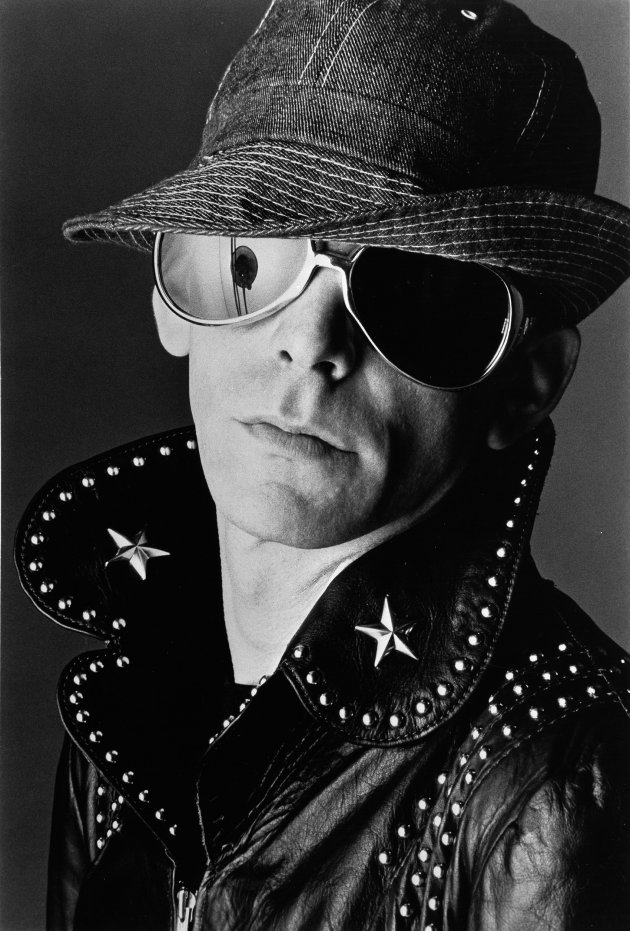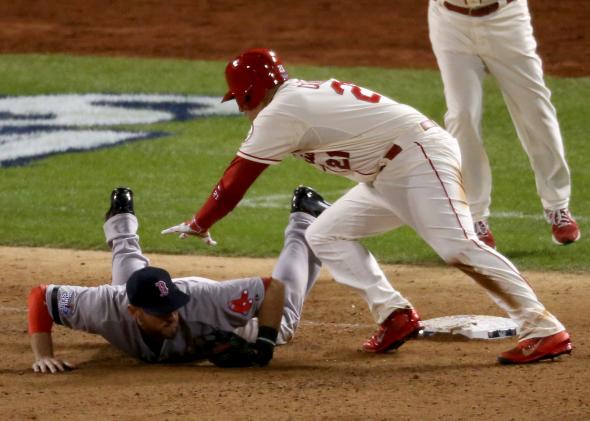
photo: Michael Ochs Archives/Getty Images
"Every song we've ever written was a rip-off of a Lou Reed song," Bono once announced from the stage, while bringing Reed up to sing on a duet of "Satellite of Love," a staple during U2's Zoo TV tour. What Bono said reconfirmed what many fans think about Reed, who died Sunday: He was a giant among rock stars, and a good deal of the punk and indie bands that followed in his wake were happy to be orbiting objects.
The most famous quote having to do with Reed's music may be apocryphal. "The first Velvet Underground record sold 30,000 copies in the first five years. I think everyone who bought one of those 30,000 copies started a band," Brian Eno is alleged to have said. We say alleged because Eno's biographer couldn't find any trace of the original aphorism (and anyway, that album, 1967's The Velvet Underground & Nico, actually sold more than 58,000 copies in its first two years of release). But: Point taken! It's hard to find even a 2010s rock band that doesn't have the Velvets as an influence, or that wouldn't at least lie and say they were, if asked.
Lou Reed was not the most influential man in rock 'n' roll; as long as Elvis Presley isn't erased from history, that'll be a hard mantle to cede. But is Lou the most cited influence in rock? Now, that one, he has a lock on. As much of a household name as he became, he never became nearly mainstream enough to become a signifying cliché. And in a celebrity culture where hotter is always better (not to be confused with White Light/White Heat), he epitomized cool to the sellout-free end.
Arguably...no, maybe make that inarguably...without Reed, we wouldn't have had punk. As the "godfather" of the movement, he was, after all, the cover boy for the very first issue of Punk magazine, a publishing moment immortalized in the recent CBGB film, which briefly dramatized Lou in his mid-'70s blond phase. And without punk, pretty much every band you liked in the last 30 years would disappear from the landscape like goodness dissipated from the alternate reality in It's a Wonderful Life. If Lou had a penny royalty from every act that owed him a debt, he'd have been able to hire Justin Bieber as his houseboy.
Morrissey found seeing the man who recorded Transformer to be a transforming experience. "At the age of 12 I went to see Lou Reed by myself. Which was extraordinary now, on reflection, to go and see Lou Reed at the age of 12 in Manchester and to survive the experience," the former Smiths frontman told Britain's Telegraph. It "seems extraordinary to me now, to imagine a 12- or 13-year-old going by themselves, to see somebody such as Lou Reed who was at the time singing exclusively about transsexuality and heroin and death and the beauty of death and the impossibility of life." To Morrissey, Reed was nothing less than "the WH Auden of the modern world."
Bono also waxed poetic with his literary comparisons, declaring, "Lou Reed is to New York what Mark Twain is to Dublin."
For many the influence had more to do with Reed's seemingly simple-to-replicate talk/sing vocal tones and streetwise lyricism than his chops, although he certainly worked with top-flight musicians over the years. In the Rolling Stone History of Rock, critic Ken Tucker cited his influence on proto-punk band the New York Dolls: "The mean wisecracks and impassioned cynicism that informed the Dolls' songs represented an attitude that Reed's work with the Velvet Underground embodied, as did the Dolls' distinct lack of musicianship."
Was he "mean"? That was the image, at least, for a long time. The Pretenders' Chrissie Hynde wasn't just influenced by him as a musician; she wrote about him when she was a rock critic at NME in the mid-'70s. Reviewing the 1974 live album Rock 'n' Roll Animal, Hynde summarized the appeal of his unwillingness to kiss up to a fanbase: "He looks like a monkey on a chain, court geek," wrote the future rock star. "Listen to him scramble to a corner, damaged and grotesque, huddled in rodent terror. Animal Lou. Lashing out in a way that could make the current S&M trend freeze in its shallow tracks. And the audience cheers after every song: we’re with you, yeah, we always loved those songs, ha ha. Well…he hates you.”
In his interview with the Telegraph decades later, Morrissey downplayed the idea of Reed as "grumpy." "He’s terribly nice! Terribly, terribly nice," insisted Morrissey — although, as an admitted misanthrope himself, Morrissey may not be the best judge of that. "And he’s one of those people who, when I first met him, I expected the worst. But he’s terribly nice. Once again, very friendly and very interested. Not a difficult, abrasive moment. But you have to remember that throughout the '70s he was exclusively drug-ravaged. And that doesn’t really make for terribly balanced relationships."
With the Sex Pistols, the influence was visible right in a name: The last half of Sid Vicious's moniker came from Reed's "Vicious." Johnny Rotten, though, was a rare non-admirer. He didn't object to Reed's music, just his association in the early '70s with the drug culture (Lou later cleaned up). According to Rotten/Lydon, Vicious "had a Lou Reed record and he believed in the druggy image Lou gave off," Lydon told The Daily Star after the band's breakup. "Sid's downfall was that he didn't get a chance to meet Lou Reed before he knew what he was doing. He would never have messed with heroin had he seen what a vacuous fat slob Lou Reed really is." Needless to say, perhaps, Lydon was influenced by Reed's cantankerousness, if nothing else.
For the British proto-punk band the Buzzcocks, it would be far harder to downplay the influence: They got together after Howard Devoto placed an ad looking for band members who could join him in playing the Velvet Underground's "Sister Ray."
Some bands came to the Velvet Underground via Jonathan Richman's Modern Lovers, who really took Reed's minimalist ball and ran with it in the early '70s, even as he was becoming more interested, for a time, in the expansiveness of glam-rock. "If the Velvet Underground had a protégé, it would be Jonathan," said Sterling Morrison. By at least one account, Richman saw the band 80 times as a youngster in the '60s. The Modern Lovers' "Roadrunner" — which some saw as a virtual rewrite of the VU — was a song that helped spur punk as we knew it. Eventually, Richman wrote and recorded a song called "Velvet Underground":
Both guitars got the fuzz tone on
The drummer's standing upright pounding along
A howl, a tone, a feedback whine
Biker boys meet the college kind
How in the world were they making that sound?
Velvet Underground
But it wasn't all attitude. There were songs there. "I like their darkness, but I also like the pop side of the Velvet Underground," Martin Gore, who certainly wasn't influenced by the group's fuzzy guitars as the mastermind behind the mostly guitar-less Depeche Mode, told Release magazine. "I do a cover of a Velvet Underground song ['Candy Says'], and they were one of the most important bands, for me."
If you want to talk about covers, the list is endless. "Satellite of Love," besides being covered by U2 every night on the Zoo TV tour (with Reed usually appearing on a video screen as duet partner), was also recorded by Eurythmics and Porno for Pyros. U2 also had "Sweet Jane" as a tour staple in the '80s, when Bono would sing it as a duet with Maria McKee of opening act Lone Justice. "Sweet Jane" was also an FM radio hit for Mott the Hoople in the early '70s and Cowboy Junkies in the late '80s. David Bowie, who produced Reed in the mid-'70s, recorded a version of "White Light/White Heat" in '73 and released it as a single a decade later. Billy Idol put out his cover of "Heroin" as a single in 1993. Duran Duran recorded two of Reed's songs, "Femme Fatale" and "Perfect Day." Both of those tunes have been widely covered by others, as well. "Femme" is in the recorded catalogs of Big Star, Tom Tom Club, R.E.M., and Elvis Costello.
"Perfect Day" covers have proven controversial: Though the lyrics are depressing in an underlying way, and some would say reflect his addiction at the time, the ostensibly upbeat title has led to seemingly "positive" cover versions, including an allstar group-sing that was a British charity single in 1997 and a variety of TV commercials. By the time Susan Boyle covered it, some Reed fans began to wonder whether his influence on pop music had extended a little too far.
These aren't even the half of it. "I'm Waiting for the Man," alone, has been covered on record or in concert by OMD, Cheap Trick, Vanessa Paradis, Bowie, and Robert Plant & Jimmy Page. An original Death Cab for Cutie song quotes from it. Joy Division, another obviously influencee, did "Sister Ray"; Nirvana, with an equally traceable lineage, did "Here She Comes Now." Roxy Music took some cues from the Velvets, so it was no surprise to see Bryan Ferry doing "What Goes On." The ballad "Pale Blue Eyes," meanwhile, has been taken up by Hole, R.E.M., Patti Smith, the Kills, Alejandro Escovedo, and the duo of Sheryl Crow & Emmylou Harris.
But Beck outdid them all — recording a cover version of the Velvet Underground & Nico album in its entirety, released exclusively to his record club. "I grew up listening to the Velvet Underground,” Beck told the Wall Street Journal when it came out this August. “When I was 15, I was taken with trying to imitate Lou Reed.” He'd covered "Sunday Morning" frequently before, but "by doing the whole album, you get to do some of the lesser-known songs you would’ve never chosen to perform. You end up learning things.” The whole thing was recorded in one day, but the album's ubiquitousness among his fellow musicians made that not a problem, Beck said: "The Velvet Underground & Nico was an obvious choice [because] everybody was familiar with it. It took us a couple of minutes to figure out the songs.”
In "Rock & Roll" — a song that was covered by the Runaways and Jane's Addiction — Reed sang about a girl whose life was "saved by rock 'n' roll." For Morrissey, Richman, Bono, Michael Stipe, David Byrne, Sonic Youth, and too many thousands of others to count, Reed, seemingly standoffish as he could be, was the very specific savior in question. Rock itself might owe Reed a saving debt.
Related links:
- Arts & Entertainment
- Music
- Reed
- Velvet Underground
Category: Bitstrips sam bradford Never Forget 9/11 Jane Addams made in america
